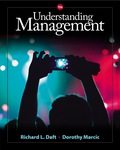
Concept explainers
To determine:
Communication strategies to be used in uncertain environments.
Introduction:
Regularly the uncertainty in an organization is related with mergers, takeovers, critical change activities, terminations and downsizings generally doing with the potential for work loss. Be that as it may, uncertainty in the working environment takes a wide range of forms. There is assurance that individuals respond to uncertainty contrastingly and there have been numerous examinations to understand why a few people cruise along while others feel deadened.
Inside a business, there are two kinds of internal communication, formal and informal. Formal correspondence spreads through bulletins, manuals, messages, reminders, staff gatherings, meetings and authority takes note. Informal correspondence or communication happens through the grapevine due to uncertainty, which is for the most part verbal correspondence. Informal business communication that travels through the grapevine spreads all through the association in a random, undocumented way and is available to steady change with individual clarification. Even though it is temporary, the grapevine conveys some significance to internal business communication.
Trending nowThis is a popular solution!

Chapter 13 Solutions
EBK UNDERSTANDING MANAGEMENT
- Are frequency distributions useful to organize data? Please discuss and provide examples where necessary.arrow_forward6. The first step in starting the research process is.. a) Searching for solutions to the problem b) Identification of the problem c) Survey of the related literature d) Searching sources of information to locate problem 7. Which of the following is NOT a form of nonrandom sampling? a) Quota sampling b) Purposive sampling c) Snowball sampling d) Convenience sampling 8. The ability to generalize the results of a study is related to.... a) External validity b) Manipulation c) Internal validity d) Predictive validity 9. Which of the following is of least concern to a qualitative researcher? a) trustworthiness b) Validity. c) Generalizability d) Understanding 10. The most important consideration in selecting a sample is that it should be........ a) Selected from a large number of individuals or elements b) Selected from the population by means of a table of random numbers c) Made up of a large number of subjects d) Representative of the populationarrow_forwardQuestion 4 Outline some suggestions regarding how to word interview questions. (10 marks)arrow_forward
- Question 3 But even with the best survey and the best results, action won't happen on its own. Your task as a business owner is to make sure the results are used. What can you do to make this happen? (8 marks)arrow_forwardOutline the steps to follow when starting to create the business report. (6 marks)arrow_forward7. Which of the following is NOT a form of nonrandom sampling? a) Quota sampling b) Purposive sampling c) Snowball sampling d) Convenience sampling 8. The ability to generalize the results of a study is related to......... a) External validity b) Manipulation c) Internal validity d) Predictive validity 9. Which of the following is of least concern to a qualitative researcher? a) trustworthiness b) Validity c) Generalizability d) Understanding 10. The most important consideration in selecting a sample is that it should be.... a) Selected from a large number of individuals or elements b) Selected from the population by means of a table of random numbers c) Made up of a large number of subjects d) Representative of the populationarrow_forward
- 6. The first step in starting the research process is.. a) Searching for solutions to the problem b) Identification of the problem c) Survey of the related literature d) Searching sources of information to locate problem 7. Which of the following is NOT a form of nonrandom sampling? a) Quota sampling b) Purposive sampling c) Snowball sampling d) Convenience sampling 8. The ability to generalize the results of a study is related to.... a) External validity b) Manipulation c) Internal validity d) Predictive validity 9. Which of the following is of least concern to a qualitative researcher? a) trustworthiness b) Validity. c) Generalizability d) Understanding 10. The most important consideration in selecting a sample is that it should be........ a) Selected from a large number of individuals or elements b) Selected from the population by means of a table of random numbers c) Made up of a large number of subjects d) Representative of the populationarrow_forward1. In which section of the research plan are the research participants described in details? a) Introduction b) Data Analysis c) Discussion d) Methodology 2. The feasibility of a research study should be considered in light of....... a) All of the above b) Potential ethical concerns c) Skills required of the researcher d) Cost and time required to conduct the study 3. Which of the following best describes quantitative research? a) Research that is exploratory b) An attempt to confirm the researcher's hypothesis c) The collection of non-numeric data d) Research that attempts to generate a new theory 4. The Qualitative research is often exploratory and has all of the following characteristics Except a) It is typically used when a great deal is already known about the topic of interest b) It relies on the collection of non-numerical data such as words and pictures c) It is used to generate hypotheses and develop theory about phenomena in the world d) It uses the inductive scientific…arrow_forwardExplain the attributes of an effective corporate leader.arrow_forward
 Management, Loose-Leaf VersionManagementISBN:9781305969308Author:Richard L. DaftPublisher:South-Western College Pub
Management, Loose-Leaf VersionManagementISBN:9781305969308Author:Richard L. DaftPublisher:South-Western College Pub Understanding Management (MindTap Course List)ManagementISBN:9781305502215Author:Richard L. Daft, Dorothy MarcicPublisher:Cengage Learning
Understanding Management (MindTap Course List)ManagementISBN:9781305502215Author:Richard L. Daft, Dorothy MarcicPublisher:Cengage Learning


